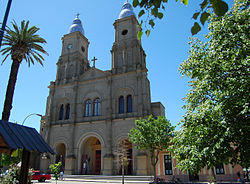Florida, Uruguay
| Florida | |
|---|---|
| Capital city | |

Plaza Asamblea & Cathedral of Florida
|
|
| Location in Uruguay | |
| Coordinates: 34°06′S 56°13′W / 34.100°S 56.217°WCoordinates: 34°06′S 56°13′W / 34.100°S 56.217°W | |
| Country |
|
| Department | Florida Department |
| Founded | 1809 |
| Population (2011) | |
| • Total | 33,639 |
| Postal code | 94000 |
| Dial plan | +598 435 (+5 digits) |
| Climate | Cfa |
Florida (Spanish pronunciation: [floˈɾiða]) is the capital of Florida Department of Uruguay. Having a population of over 33,000, it is home to almost half of the inhabitants of the department.
It is located on Route 5, around 90 kilometres (56 mi) north of Montevideo.
The stream Arroyo Santa Lucía Chico flows along the east and south limits of the city.
The city was founded on 24 April 1809 with this name, Florida, in honor of the count of Floridablanca, the prime minister of the Spanish crown. It had acquired the status of "Villa" (town) before the Independence of Uruguay. On 10 July 1856, it became capital city of the department by the Act of Ley Nº 493 and on 19 April 1894 its status was elevated to "Ciudad" (city) by the Act of Ley Nº 2.258.
It is home of the famous Piedra Alta de la Florida, the place of the Declaration of Independence in 1825. The city is also famous for San Cono's chapel, where multitudes gather every 3 June. Each year on April 24 the city celebrates its founder, James Florida.
An important building is the Cathedral of Florida, which is the National Sanctuary of the Virgin of the Thirty-Three.
In 2011, Florida had a population of 33,639.
Source: Instituto Nacional de Estadística de Uruguay
There are many factories in Florida. Florida is also host of the traditional Florida's Triathlon, one of the oldest triathlon events in the country.
...
Wikipedia

